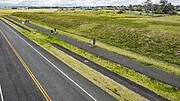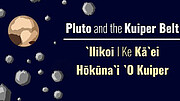Take a Walk Through the Solar System at Waimea, Hawaiʻi
The Waimea Solar System Walk returns self guided
6 April 2021
The annual Waimea Solar System Walk is taking place this year from 15 March to 15 April 2021 as an in-person/virtual hybrid event in the town of Waimea on Hawai‘i Island, with some adjustments to accommodate COVID-19 safety measures.
The self-guided and socially-distanced walk involves a series of sidewalk decals, each representing a different Solar System object. The decals are spaced out in proportion to the true distances between objects in the Solar System, allowing participants to ‘walk the Solar System’. An informative video about each object is accessible via a QR code at each decal. The videos are available in both English and for the first time also in ‘Ōlelo Hawaiʻi (the Hawaiian Language).
The W. M. Keck Observatory, Canada France Hawaiʻi Telescope (CFHT) and University of Hawai‘i Institute for Astronomy in Hilo worked together to design this year's walk and NSF NOIRLab participated in the production and translation of materials for the event.
The ʻŌlelo Hawaiʻi scripts for every video were created by Alyssa Leinani Lozi, an outreach assistant at NOIRLab’s Gemini Hilo Base Facility. Lozi is a 2nd-year language student at Ka Haka ʻUla o Keʻelikōlani, College of Hawaiian Language at the University of Hawaiʻi at Hilo. She was assisted in researching the traditional and contemporary names of planets in ʻŌlelo Hawaiʻi by Alexis Acohido, a telescope operator at the East Asian Observatory/James Clerk Maxwell Telescope. Lozi’s Kumu (teacher), Isaac Kealohapauʻole Ahuna, assisted in editing the scripts.
“Direct translations from English to Hawaiian can be difficult for a novice student like myself, so rather than directly translating what everyone said in their Solar System Walk videos, I wrote my own new and simplified scripts for each object,” Lozi explained. “The streamlined scripts allowed me to think in ‘Ōlelo Hawai’i while writing.”
Lozi herself is featured reading her scripts in three of the eight Solar System walk videos [1]. The remaining five scripts were read by Shelly Pelfrey and Matthew Brown, both from the W. M. Keck Observatory. The Waimea Solar System Walk was originally a one-day event led by CFHT and Keck Observatory, with participation from nearly all the other Maunakea Observatories including the international Gemini Observatory.
Notes
[1] The scripts Lozi reads are: Venus, Uranus, and Pluto and the Kuiper Belt Objects. In addition, Jameeka Marshall, outreach assistant at NOIRLab is featured in the English section of the Jupiter video.
More information
NSF NOIRLab (National Optical-Infrared Astronomy Research Laboratory), the US center for ground-based optical-infrared astronomy, operates the international Gemini Observatory (a facility of NSF, NRC–Canada, ANID–Chile, MCTIC–Brazil, MINCyT–Argentina, and KASI–Republic of Korea), Kitt Peak National Observatory (KPNO), Cerro Tololo Inter-American Observatory (CTIO), the Community Science and Data Center (CSDC), and Vera C. Rubin Observatory (in cooperation with DOE’s SLAC National Accelerator Laboratory). It is managed by the Association of Universities for Research in Astronomy (AURA) under a cooperative agreement with NSF and is headquartered in Tucson, Arizona. The astronomical community is honored to have the opportunity to conduct astronomical research on Iolkam Du’ag (Kitt Peak) in Arizona, on Maunakea in Hawaiʻi, and on Cerro Tololo and Cerro Pachón in Chile. We recognize and acknowledge the very significant cultural role and reverence that these sites have to the Tohono O'odham Nation, to the Native Hawaiian community, and to the local communities in Chile, respectively.
Links
Contacts
Amanda Kocz
Press and Internal Communications Officer
NSF NOIRLab
Cell: +1 520 318 8591
Email: amanda.kocz@noirlab.edu






















